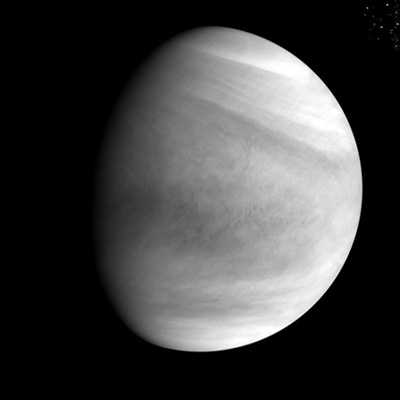Japanese Venus probe sends back first science data
In a triumph of engineering, the salvaged Japanese Venus probe Akatsuki has beamed back to Earth its first science data.
After an unplanned five-year detour, Japan’s Venus probe, Akatsuki, has come back to life with a bang. On 4–8 April, the Japan Aerospace Exploration Agency (JAXA) presented the first scientific results from the spacecraft since it was rescued from an errant orbit around the Sun and rerouted to circle Venus, four months ago. These include a detailed shot of streaked, acidic clouds and a mysterious moving ‘bow’ shape in the planet’s atmosphere.
Despite the probe’s tumble around the Solar System, its instruments are working “almost perfectly”, Akatsuki project manager Masato Nakamura, a planetary scientist at JAXA’s Institute of Space and Astronautical Science in Sagamihara, Japan, announced at the International Venus Conference in Oxford, UK. And if another small manoeuvre in two years’ time is successful, he said, the spacecraft might avoid Venus’s solar-power-draining shadow, and so be able to orbit the planet for five years, rather than the two it was initially assigned.
The timing is also good, since Akatsuki is now the only probe circling Venus, and will be for a number of years, until someone else approves, builds, and launches a mission.
In a triumph of engineering, the salvaged Japanese Venus probe Akatsuki has beamed back to Earth its first science data.
After an unplanned five-year detour, Japan’s Venus probe, Akatsuki, has come back to life with a bang. On 4–8 April, the Japan Aerospace Exploration Agency (JAXA) presented the first scientific results from the spacecraft since it was rescued from an errant orbit around the Sun and rerouted to circle Venus, four months ago. These include a detailed shot of streaked, acidic clouds and a mysterious moving ‘bow’ shape in the planet’s atmosphere.
Despite the probe’s tumble around the Solar System, its instruments are working “almost perfectly”, Akatsuki project manager Masato Nakamura, a planetary scientist at JAXA’s Institute of Space and Astronautical Science in Sagamihara, Japan, announced at the International Venus Conference in Oxford, UK. And if another small manoeuvre in two years’ time is successful, he said, the spacecraft might avoid Venus’s solar-power-draining shadow, and so be able to orbit the planet for five years, rather than the two it was initially assigned.
The timing is also good, since Akatsuki is now the only probe circling Venus, and will be for a number of years, until someone else approves, builds, and launches a mission.

